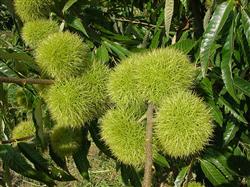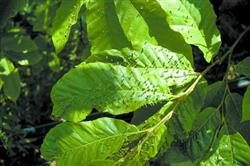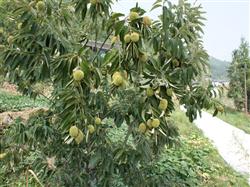How to fertilize chestnut scientifically?

How to fertilize chestnut scientifically? Please give a detailed description of chestnut fertilizer requirements like other fruit trees, the difference is that in addition to sufficient nitrogen, phosphorus and potassium, it is particularly sensitive to medium element magnesium and a small amount of manganese and boron, such as lack or deficiency, serious physiological obstacles will occur and affect growth and development. According to the determination, Chinese chestnut is a fruit tree with high manganese demand. The content of manganese in the leaves with normal growth and development is 1000mg / kg and 2500mg / kg. If it is less than 1000 mg / kg, the leaves will be yellowed and the growth will be hindered. If there is a lack of magnesium or insufficient supply, there will be yellowing between the veins, and the discolored part will gradually turn brown and die. Because boron is an important element in promoting pollen germination, pollen tube growth and ovary development, soil boron deficiency will lead to empty buds. According to the investigation, the results of the chestnut orchard with soil available boron content of 0.56-0.87 mg / kg were normal, the empty bract rate was only 3%-6.9%, and the yield of the chestnut orchard with 0.2-0.4 mg / kg content was very low, and the empty bract rate was as high as 44%-81%. The root was continued in Meiyuan Village, Dongling Township, Jianchuan County. when planting Chinese chestnut, 100 grams of boron sand was added to the base fertilizer, and 350 times borax water was sprayed once a year after planting, which was two years earlier than that without boron application and boron spraying. The demand for nitrogen, phosphorus and potassium is large, and the absorption period is different. The amount of nitrogen absorbed was large and lasted for a long time, and it was continuously absorbed from the beginning of bud germination to before fruit harvest, and the absorption was the most in the period of rapid expansion of fruit, which decreased gradually after harvest. The absorption time of phosphorus is stable from after flowering to before harvest, but the absorption amount is less, and the absorption time is shorter than that of nitrogen and potassium. However, phosphorus is very important to the fruiting performance and yield of Castanea mollissima. According to the determination, the content of available phosphorus in the soil of high-yield orchard is as high as 20.18-27.00mg / kg, and the content of phosphorus in new shoots is 2420 mg / kg. The content of phosphorus in low-yield orchard is only 1mg / kg, and the content of phosphorus in new shoots is as low as 1360 mg / kg. Phosphorus is an important substance to promote flower bud differentiation, fruit development, seed ripening and quality. Potassium was absorbed in a small amount before flowering, increased gradually after flowering, was absorbed the most in the fruit hypertrophy period, and decreased sharply after harvest. It is proved that in the annual growth cycle, from the differentiation of male flowers in early spring to flowering and fruit setting, nitrogen is the most, followed by potassium, and phosphorus is less; from flowering to fruit expansion, phosphorus is the most, followed by nitrogen and potassium; from fruit fat stage to harvest, potassium is the most, followed by nitrogen, and phosphorus is less. Key points of fertilization for young trees under 7 years old, according to the principle of "frequent light application, less quantity, less first, then more, first light and then dense", the interval of fertilization should be short, the concentration should be light, the times should be more, the amount of fertilizer should be less, and the number of times should be decreased and increased with the increase of tree age. In general, 1-year-old 3-year-old trees, from the beginning of February to the end of May, apply available nitrogen fertilizer every 40 to 45 days, each time 15 kg of human and animal feces or 20 kg of urea to promote the germination and growth of branches and leaves. From the beginning of June to the end of August, the total fertilizer of nitrogen, phosphorus and potassium was applied every 40 to 45 days, with 30g of ternary compound fertilizer per plant, in order to promote the development, ripening and enrichment of branches and shoots. The 4-year-old 7-year-old tree was topdressing every two months from February to August, still dominated by nitrogen in the early stage, followed by potassium, followed by phosphorus, and applied nitrogen, phosphorus and potassium ternary compound fertilizer in the middle and later stage, but the amount of fertilizer should increase with the increase of tree age year by year. The suitable proportion of N, P and K application in the whole year is 1 ∶ 0.7 ∶ 0.8. 300 tons of 350 times borax water is sprayed once in April and June every year to promote it to be put into production earlier. After entering the fourth year of growth, the whole ring ditch or semi-ring ditch was used to apply base fertilizer. Fruit-bearing trees should be fertilized three times a year, and the ratio of nitrogen, phosphorus and potassium needed for the whole year is about 1 ∶ 0.85 ∶ 0.9. ① pre-flowering fertilizer was applied in combination with spring water in March after germination and before flowering. 100 kg of human and animal manure or 350 kg of urea was applied per plant to promote leaf sprouting, flowering and fruiting, and increase fruit setting rate and yield. ② strong fruit fertilizer was applied in the period of rapid fruit expansion, applying N, P and K ternary compound fertilizer 800g to 1000g per plant to promote fruit development and improve fruit quality. ③ base fertilizer is the basic fertilizer for the growth and development of chestnut throughout the year, which requires complete elements, coordinated proportion, large amount of fertilizer, high concentration and timely application. Barnyard manure, compost, soil manure, retting garbage fertilizer, sugar mud, green manure and cake fertilizer can be used for fertilizer. Red soil or yellow soil with low available phosphorus and boron should be added with appropriate amount of chemical phosphate fertilizer and boron sand. In general, trees with moderate potential, medium fertility and more fruit should be treated with rotten barnyard manure 80 kg, calcium superphosphate 3 kg, and boron sand 100 kg. The best application is from September to October after fruit harvest. Methods semi-ring trenches, radiation ditches, fan-shaped pits and strip ditches were used, and the roots were covered with trees in the whole garden. In addition, no matter small trees or big trees, from May to July, pesticides should be sprayed in combination with the control of diseases and pests, and mixed spraying of manganese and magnesium should be added to supplement micro-fertilizer. its concentration is 3500 times of manganese sulfate and 2500 times of magnesium sulfate. When borax is sprayed in full bloom, it is suitable to spray 300 times to 350 times. Click to get more chestnut planting techniques click to get more fruit planting techniques
- Prev

What are the main pests of Chinese chestnut?
What are the main pests of Chinese chestnut? Please introduce the occurrence characteristics and control methods of chestnut gall wasp and cloud spot longicorn beetle as follows: first, chestnut gall wasp 1. The morphological characteristics of adults are black wasps, with a body length of 2mi 3mm and transparent front and rear wings. The egg is oval, 0.2 mm long, milky white, with a tail.
- Next

How to fertilize chestnut trees in summer?
How to fertilize chestnut trees in summer? Please give guidance to the method of planting chestnut trees in summer can refer to the following two methods of fertilization: soil fertilizer method: the soil fertilizer method is better for chestnut orchards with thin soil and serious lack of fertilizer. In the chestnut crown drip line, dig a circular trench to fertilize, ditch width 2.
Related
- Moge, come on! The staff of the peasant association in the producing area of cantaloupe were frightened when the crowd gathered.
- Causes and Solutions of low Fruit setting rate of Apple
- Symptoms and control measures of passion fruit virus disease
- Fruit growing lesson: how do apple orchards keep high yields?
- Can you build orchards in the mountains? What are the pros and cons?
- How to manage the coloring period of Crisson grape?
- This paper introduces the processing technology of two kinds of fig products.
- How much is a month for retired teachers in rural areas by 2020?
- How can strawberry planting increase sugar content? We should pay attention to management in many aspects.
- What are the cultivation techniques on how to improve the yield of golden fruit?

